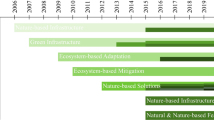Abstract
Ewaso Narok Swamp, formed along the Eng'are Narok river, is located in the semi-arid part of the Laikipia District, Kenya. The area, of bushy grassland, is characterised by low rainfall (less than 750 mm annually) and episodic rivers. Before the 1970s, the dominant land use was large scale ranching and nomadic pastoralism. Since 1970, this has slowly been transformed into high density small-scale farming. There has been a strong trend towards settlement along riverine and wetland areas due to their suitability for farming and easy availability of water for cultivation. Ewaso Narok swamp has a rich species diversity of over 170 bird species, resident and migrant, over 100 plant species and it also provides an important dryland refuge for both domestic and wild animals. The swamp also provides socio-economic products such as plant matter for building. The result of its land use transformation has been ecosystem alteration, habitat modification and destruction both for wetland and rangeland species. This change has also been accompanied by escalating human–wildlife conflict. However, although this process is self-destructive, the lack of economic returns from wildlife to some extent justify the land use transformation since the communities settling here have to satisfy the basic requirements of food and shelter. This poses the challenge of the developing appropriate ways to conserve the dryland wetlands whilst attaining maximum returns for the local community.
Similar content being viewed by others
References
Backeus, I., 1993. Ecotone versus ecocline: vegetation and dynamics around a small reservoir in Tanzania. J. Biogeogr. 20: 209–281.
Cain, S. A. & G. M. De Oliveria Castrol, 1959. Manual of Vegetation Analysis. Haffer Pubs, New York.
Fuller, R. J. & D. R. Langslow, 1984. Estimating the number of Birds by Point Count: how long should counts last? Bird Study 31: 195–202.
Gaudet, J. J., 1977. Natural Draw Down on Lake Naivasha Kenya and the Formation of papyrus Swamps. Aquat. Bot. 3: 1–47.
Gichuki, F., 1992. Utilization and conservation of wetlands: an agricultural drainage perspective. In Crafter, S. A., S. G. Njuguna, G. W. Howard (eds), Wetlands of Kenya, Proceedings of the Kenya Wetlands Working Group Seminar on Wetlands of Kenya, National Museums of Kenya, Nairobi, Kenya 3–5 July 1991. Vii + 183 pp.
Government of Kenya, 1994. District Development Plan, Laikipia District. Government Press, Nairobi, Kenya.
Hackman, B. D., 1988. Geology of the Baringo-Laikipia Area. Geological Report 104. Republic of Kenya, Nairobi.
Huber, M & C. J. Opondo (eds), 1995. Land Use Changes Scenarios for Subdivided Ranches in Laikipia District Kenya. Laikipia-Mt. Kenya Reports 19. Laikipia Research Programme and Institute of Geography, University of Berne Switzerland.
IUCN/UNEP/WWF, 1991. Caring for the Earth. A Strategy for Sustainable Living. IUCN, Gland, Switzerland.
Kareri, R. W., 1992. The sociological and economic values of Kenya';s wetlands. In Crafter, S. A., S. G. Njuguna & G. W. Howard (eds), Wetlands of Kenya, Proceedings of the Kenya Wetlands Working Group Seminar on Wetlands of Kenya, National Museums of Kenya, Nairobi, Kenya 3–5 July 1991. Vii + 183 pp.
Laikipia Research Programme, 1996. District Atlas Laikipia Research Programme and the Ministry of Land Reclamation Regional and Water Development. Laikipia Research Programme, Nanyuki, Kenya.
Mathuva, J. M. & B. P. Kiteme (eds), 1997. A Pre-drainage Environmental Impact Study (PDEIS) for Laikipia Wetlands, Laikipia District. ASAL Development Programme, Laikipia. Laikipia Research Programme and Institute of Geography University of Berne Switzerland.
Muiruri, W., 1977. The Aberdare Ecosystem, its Bio-economic Functions, Interactions and Problems of Management, Unpublished Ph.D Thesis, University of Nairobi.
Odak, O., 1992. Material culture and design. In Crafter, S. A., S. G. Njuguna & G.W. Howard (eds), Wetlands of Kenya, Proceedings of the Kenya Wetlands Working Group Seminar on Wetlands of Kenya, National Museums of Kenya, Nairobi, Kenya 3–5 July 1991. Vii + 183 pp.
Odongo, O. R., 1996. Building an Inventory of Kenya's Wetlands: An Ethanobotany Study of Wetlands Plants of Uasin Gishu District of Kenya. Kenya Wetland Working Group, 1996. 35.
Pomery, D., 1992. Counting Birds. A guide to Assessing Numbers, Biomass and Diversity of Afrotropical Birds, Makerere University Institute of Environment and Natural Resources, Kampala, Uganda.
Ralph, C. J. & J. M. Scott, 1981. Estimating the Number of Terrestrial Birds. Studies in Avian Biology No. 6, Copper Ornithological Society Allen Press, KS, USA.
Taiti, S. W., 1992a. Livestock Numbers and Enterprises in Laikipia District Central Mukogondo Divisions. Laikipia-Mt. Kenya Paper D-7 Laikipia Research Programme, Nanyuki.
Taiti, S. W., 1992b. The vegetation of Laikipia District, Kenya. Laikipia-Mt. Kenya Papers B-2 Laikipia Research Programme, Nanyuki.
Tandiga, 1990. Vegetation Sampling, Unpublished Field Manual, Department of Range Management, University of Nairobi.
Thenya, T., 1998. Some Ecological Aspects, Bio-economic Values and Human Impact of a Tropical Papyrus Wetland, Ewaso Narok swamp, Laikipia District, Kenya. M.Sc Thesis Department of Geography, University of Nairobi.
Steel, R. G. D. & J. D. Torrie, 1986. Principles and Procedures of Statistics, Second Edition. McGraw-Hall, New York.
Wood, A., 1997. Wetlands in Highlands: The Search for Sustainable Use of Valley Bottom Swamp in the Highlands of Southwest Ethiopia. Department of Geographical and Environmental Sciences, University of Huddersfield, UK.
Author information
Authors and Affiliations
Rights and permissions
About this article
Cite this article
Thenya, T. Challenges of conservation of dryland shallow waters, Ewaso Narok swamp, Laikipia District, Kenya. Hydrobiologia 458, 107–119 (2001). https://doi.org/10.1023/A:1013196500456
Issue Date:
DOI: https://doi.org/10.1023/A:1013196500456




